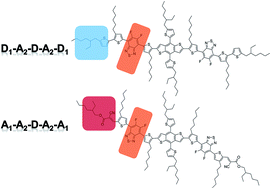Understanding effects of two different acceptors in one small molecule for solution processable organic solar cells†
Abstract
Introducing two different electron-withdrawing groups into the molecular backbone is one of the effective methods to extend absorption and lower the highest occupied molecular orbital (HOMO) energy level for a high open-circuit voltage (Voc). However, examples of two-acceptor type small molecules are less studied. In order to understand the effect of two acceptors, two kinds of small molecules named as BDT(dFBT-TT)2 with a single acceptor unit and BDT(dFBT-ON)2 with two acceptor units have been synthesized, respectively. However, the power conversion efficiency (PCE) of the BDT(dFBT-ON)2 device is lower (3.54%) than that of BDT(dFBT-TT)2 (5.55%). Grazing incidence wide angle X-ray scattering (GIWAXS) and the intensity dependence of current–voltage characteristics were used to study the spatially periodic order and charge recombination of these small molecules. Although the Voc of BDT(dFBT-ON)2 is higher than that of BDT(dFBT-TT)2, the short circuit current (Jsc) of BDT(dFBT-ON)2 is lower due to a higher ratio of charge carrier recombination. For the sake of getting a high Voc and Jsc simultaneously in the future, this work would supply valuable insights for designing multi-acceptor-type small molecules.


 Please wait while we load your content...
Please wait while we load your content...